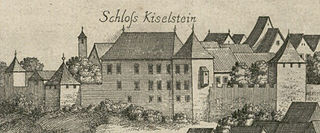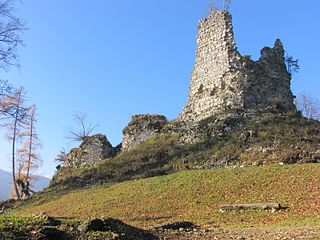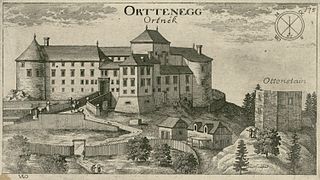
Celje is the fourth-largest city in Slovenia. It is a regional center of the traditional Slovenian region of Styria and the administrative seat of the City Municipality of Celje. The town of Celje is located below Upper Celje Castle at the confluence of the Savinja, Hudinja, Ložnica, and Voglajna rivers in the lower Savinja Valley, and at the crossing of the roads connecting Ljubljana, Maribor, Velenje, and the Central Sava Valley. It lies 238 m (781 ft) above mean sea level (MSL).

Kostel is a settlement in the Municipality of Kostel in southern Slovenia. It is located on the left bank of the Kolpa River next to the border with Croatia. It is part of the traditional region of Lower Carniola and is now included in the Southeast Slovenia Statistical Region.

Ulrich II, or Ulrich of Celje, was the last Princely Count of Celje. At the time of his death, he was captain general and de facto regent of Hungary, ban (governor) of Slavonia, Croatia and Dalmatia and feudal lord of vast areas in present-day Slovenia, Croatia, Bosnia, Austria, and Slovakia. He was also a claimant to the Bosnian throne. He was killed by agents of the Hunyadi clan under unknown circumstances, which plunged Hungary into civil unrest that was resolved a year later by the sudden death of king Ladislas the Posthumous and the election of Matthias Corvinus, the son of John Hunyadi and Ulrich's son-in-law, as king. Ulrich's possessions in the Holy Roman Empire were inherited by Emperor Frederick III, while his possessions in Hungary were reverted to the crown.

Lurnfeld is a market town in the district of Spittal an der Drau in the Austrian state of Carinthia. The municipality consists of the two Katastralgemeinden: Möllbrücke and Pusarnitz, comprising several small villages.

Samobor Castle is a ruined castle atop of Tepec hill in Samobor, Croatia. It lies only a 10-minute walk away from the city centre. Remains of the old castle moat are still visible, as well as the massive entrance and most of the walls.

Brežice Castle is a 16th-century castle in the town of Brežice, in southeastern Slovenia, at the street address Cesta prvih borcev 1.

Kieselstein Castle, also known as Khislstein, is a 13th-century castle in the city of Kranj, in the Upper Carniola region of Slovenia.

Lipnica Castle, also known as Deserted Castle above Lipnica, is a castle ruin near the settlement of Zgornja Lipnica in Upper Carniola, above Lipnica Creek, in the Municipality of Radovljica.

Weissenfels Castle is a castle ruin above the settlement of Fusine in Valromana in the extreme northeast corner of Italy. The ruins are located 5.7 kilometers (3.5 mi) from the tripoint between Slovenia, Austria, and Italy.

Niederfalkenstein Castle is a medieval castle near Obervellach in Carinthia, Austria. It is part of the larger Falkenstein fortification complex; while the main fortress of Oberfalkenstein today is a ruin, the lower barbican of Niederfalkenstein is largely preserved.

Ortenburg Castle is a ruined mediaeval castle located in Baldramsdorf, in the Austrian state of Carinthia. It is located on the northern slope of Mt. Goldeck, part of the Gailtal Alps, above the Drava valley at a height of 740 m (2,430 ft).

Sommeregg is a medieval castle near Seeboden in the Austrian state of Carinthia, Austria. It is situated in the foothills of the Nock Mountains at an altitude of 749 m.

Ortnek Castle is a 12th-century castle ruin in the vicinity of the town of Ribnica, Slovenia. The ruin stands on Big Žrnovec Hill, near the village of Hudi Konec.

Leskovec Castle or Turn Castle is a 15th-century castle north of the village of Leskovec pri Krškem, southeastern Slovenia. It has been redesigned in the 16th and the 18th centuries.

Polhov Gradec Castle is a castle ruin above the settlement of Polhov Gradec, in the Municipality of Dobrova–Polhov Gradec in central Slovenia. It is located on Calvary Hill immediately northwest of the town center.

Lož Castle, also known as Pusti Grad, is a castle ruin above the settlement of Lož in central Slovenia's Lož Valley. The castle and its lordship are mentioned in period documents under various names, including Los, Louse, Lose, and Lösch.

Čušperk is a village in the Municipality of Grosuplje in central Slovenia. It lies in the hills south of Grosuplje in the historical region of Lower Carniola. The municipality is now included in the Central Slovenia Statistical Region.

John II of Gorizia was the penultimate Count of Gorizia. He ruled the County of Gorizia from 1454 until his death.

Fusine in Valromana is a frazione of the comune of Tarvisio in the Province of Udine, in the autonomous Friuli-Venezia Giulia region of northeastern Italy.

Frederick I of Celje, also Frederick I of Cilli, was a Styrian free noble who became the first Count of Celje, founding a noble house that would dominate Slovenian and Croatian history in the first half of the 15th century.





















